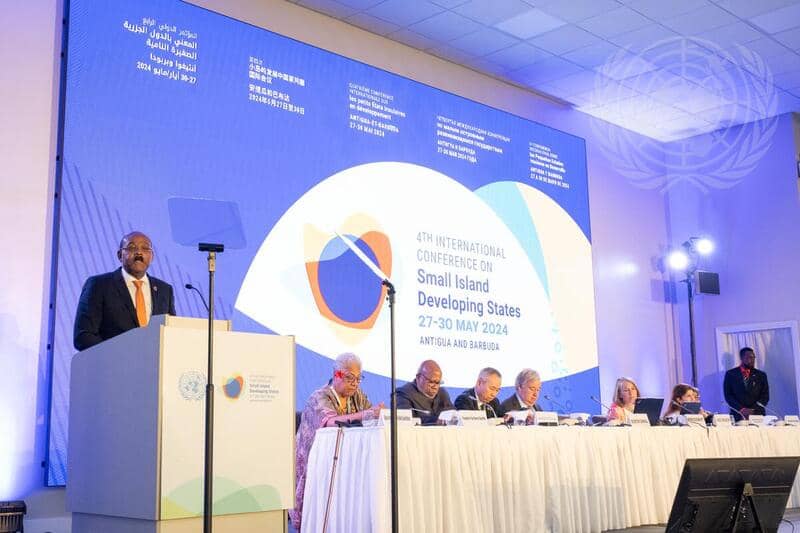
The recent devastation wrought by Hurricane Beryl in early July, as it ripped through the Caribbean and beyond, leaving flooding, storm surges, broken buildings and shattered lives, brought the bitter realities of the climate crisis into stark relief.
As Small Island Developing States (SIDS), Caribbean nations are particularly vulnerable to extreme weather events and climate change, with children and young and people bearing the brunt, both physically and psychologically, with bodies less able to cope with weather emergencies and pollution.
Young activists and visionaries from across the globe recognize this existential threat to their future and they are coalescing, strategizing, organizing and building a movement to ensure that their voices are heard in international dialogues. UNICEF’s Office for the Eastern Caribbean Area has been instrumental in opening up pathways to greater youth engagement in such arenas.
A landmark Summit
In a groundbreaking move, on the eve of the Fourth International Conference on Small Island Developing States (SIDS4) held in Antigua and Barbuda at the end of May, 90 youth activists came together for the landmark Children and Youth Action Summit (CYAS). Representing the three SIDS regions; the Caribbean, the Pacific, and the Atlantic, Indian Ocean and South China Sea, delegates championed and ratified a Commitment to Action, a 10-year plan that will mirror the new Antigua and Barbuda Agenda for SIDS, the conference outcome document.
The CYAS Commitment (also known as the Hawksbill Agreement) has four pillars: safe and prosperous societies, resilient economies, a secure future and environmental integrity and planetary sustainability. The young delegates were able to share the Commitment at the main SIDS4 event which attracted heads of state and other global leaders including the UN Secretary-General Antonio Guterres. Many of these leaders had already added their pledges to a Wall of Commitment at the CYAS, a striking visual representation of promises for a better future from one generation to the next. The event was hosted by UNICEF, the youth-led Ashley Lashley Foundation and the Government of Antigua and Barbuda.
A springboard
The Summit was clearly not an end in itself: it is intended to be a springboard for ever greater and more meaningful engagement of young people in issues that matter deeply to them, issues that will determine the quality, success and scope of their lives and the lives of future generations. Concrete steps have been taken. The Alliance of Small Island States Youth Council emerged from the gathering and this new youth-led body will work to ensure that the tenets of the Commitment to Action gain traction in international spaces.
The Youth Council will work alongside UNICEF and partners to see that the needs of children and young people are reflected in the development, policies and programmes of the Global SIDS Centre of Excellence which was established at the SID4 conference. The Centre is designed to strengthen innovation, research, resilience and knowledge sharing among SIDS.
“It’s why we continue the work we do”
Activists from the youth summit are already claiming space at high-level international gatherings. Barbadian Naomi Cambridge, a member of the Ashley Lashley Foundation, addressed an event at the UN High-Level Political Forum on Sustainable Development on 9 July. She spoke passionately and eloquently about the CYAS being a “catalyst” for increased youth involvement. She added, “Coming from such as small island and vulnerable region, the actions we are taking as youth and the decisions being made globally mean everything for our future as a region and as a generation. It is why we continue the work that we do.”
Within the next few months, it is hoped that the Commitment to Action can also provide a building block for the upcoming Pact for the Future to be unveiled at September’s UN General Assembly Summit for the Future. Youth and Future Generations is one of the five critical pillars of the Pact.
Pieter Bult, UNICEF’s Representative for the Eastern Caribbean Area, acknowledges the importance of consolidating gains made at the CYAS.
“Following the success of the Children and Youth Action Summit, as UNICEF we will continue to promote youth engagement and work with children and young people to ensure that they are part of the debate, that they have meaningful pathways to greater involvement and that we assist in capacity building to support them as they take their rightful place centre stage,” he said.
Advertise with the mоѕt vіѕіtеd nеwѕ ѕіtе іn Antigua!
We offer fully customizable and flexible digital marketing packages.
Contact us at [email protected]

















